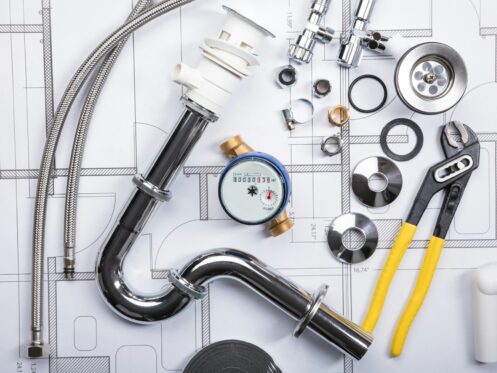Dealing with plumbing issues in your kitchen sink can be frustrating and inconvenient. Common problems include clogged drains, leaky faucets, and low water pressure, each presenting unique challenges. Understanding these issues can help you identify the best solutions and prevent further complications.
When you notice that your kitchen sink is draining slowly or making strange noises, it’s essential to address the problem promptly. Ignoring these signs can lead to more significant plumbing issues down the line. With Splash Plumbing, you can find effective, professional solutions to restore your kitchen sink’s functionality.
Whether you’re facing a severe clog or a minor leak, knowing the typical plumbing problems that affect kitchen sinks can save you time and prevent costly repairs. If you need assistance, Splash Plumbing is here to help you navigate these challenges and ensure your kitchen plumbing operates smoothly.
Understanding Kitchen Sink Plumbing
Understanding how your kitchen sink plumbing works can save you time and money. Key components and configurations play critical roles in ensuring that your sink operates efficiently and effectively.
Components and Functionality
The primary components of kitchen sink plumbing include pipes, trap, and venting systems. The pipes transport water to and from the sink, typically made of materials like PVC, copper, or stainless steel. The trap, usually a P-shaped bend in the pipe, prevents sewer gases from entering your home while allowing waste to flow out. Proper venting is essential because it maintains air pressure in the plumbing system, facilitating smooth drainage.
Additionally, faucets and garbage disposals are crucial parts of the system. Your faucet controls water flow, while the disposal helps grind food waste. Regular maintenance of these components ensures longevity. If issues arise, knowing these parts can assist you and your plumber in diagnosing the problem accurately.
Common Plumbing Configurations
Kitchen sink plumbing configurations can vary, but most involve standard layouts that include a single or double basin design.
In a straight configuration, the sink’s drain aligns directly with the home’s main drainage line. In contrast, an offset configuration has the sink positioned slightly away from the drain line, often requiring additional piping.
The connections typically feature flexible hoses for easier installation and adjustments. The inclusion of shut-off valves allows you to manage water flow for repairs, reducing mess and potential damage. Splash Plumbing can help you resolve issues with various plumbing configurations, ensuring that your kitchen sink remains functional and efficient.
Identifying Common Sink Plumbing Issues
Understanding sink plumbing issues is essential for maintaining an efficient kitchen. Identifying problems early can prevent costly repairs and ensure your plumbing functions smoothly.
Leaks and Their Causes
Leaks are among the most common plumbing issues you may encounter. They often occur at the faucet, drain, or under the sink. Common causes include worn-out washers, loose fittings, or corroded pipes. Water damage from leaks can lead to mold growth and structural issues.
To identify leaks, check for signs of moisture or puddles under the sink. Inspect faucet connections and the drain assembly for dampness. If you suspect a leak but can’t see it, monitor your water bill for unexplained increases. For persistent leaks or difficult repairs, consider contacting a qualified plumber like Splash Plumbing for accurate diagnosis and resolution.
Clogs and Drain Efficiency
Clogs can severely hinder your kitchen sink’s functionality. Food particles, grease, and soap scum can accumulate over time, leading to blockages in the drain. Recognizing the signs of a clog early is crucial. You may notice slow-draining water or unpleasant odors emanating from the sink.
To address minor clogs, try using a plunger or a mixture of baking soda and vinegar. For more stubborn blockages, you might need a plumber’s snake or professional assistance. Splash Plumbing specializes in effective drainage solutions and can help restore your sink’s efficiency quickly.
Water Pressure Concerns
Low water pressure can be frustrating when using your kitchen sink. Various factors can contribute to this, such as supply line obstructions, corrosion within pipes, or issues with the faucet itself. If water flows unevenly or is weak, it could indicate a problem worth investigating.
To troubleshoot low water pressure, check other faucets in your home. If the issue is isolated to your kitchen sink, inspect the aerator for mineral buildup. Cleaning or replacing the aerator can often resolve minor pressure issues. If problems persist, reach out to Splash Plumbing, as they can diagnose and fix underlying issues affecting your water supply.
Maintaining Your Kitchen Sink
Maintaining your kitchen sink is essential for preventing clogs and ensuring it remains in good working order. Proper care can eliminate foul odors and buildup, while also prolonging the lifespan of your materials, such as stainless steel and plumbing fixtures.
Regular Cleaning and Upkeep
To keep your kitchen sink clean, establish a regular cleaning schedule. Use mild dish soap and warm water for daily wipe-downs to prevent residue buildup.
Weekly tasks can include:
- Scrubbing the sink with a non-abrasive cleaner
- Cleaning the aerator to ensure proper water flow
- Inspecting for leaks or any signs of wear
Additionally, avoid leaving food scraps in the sink for extended periods, as this can lead to clogs. By maintaining a routine, you can keep your sink looking pristine and functioning efficiently.
Natural Solutions for Sink Maintenance
For maintaining your sink without harsh chemicals, consider natural remedies. Regularly pour a mixture of baking soda and vinegar down the drain. This combination helps to break down grease and prevent buildup. Follow this with hot water to flush everything away.
Another effective method is to use white vinegar on a cloth to wipe down stainless steel surfaces. This not only cleans but also removes odors effectively. These natural solutions are easy to implement and keep your sink safe from harmful substances.
Garbage Disposal Care
Taking care of your garbage disposal is crucial for avoiding unpleasant odors and potential clogs. Always run cold water when using the disposal to help food particles break down more efficiently.
To keep your disposal clean, regularly grind ice cubes made of vinegar. This method sharpens the blades and controls odors.
Avoid disposing of fibrous materials, such as celery or potato peels, as these can lead to jams. If you experience any issues, consult with professionals like Splash Plumbing for expert assistance in Anaheim, CA.
DIY Fixes for Minor Sink Problems
Addressing minor sink issues can save you time and money. With some simple DIY fixes, you can troubleshoot common problems like clogs and leaks effectively.
Unclogging a Drain
A slow or clogged sink can be tackled using a few methods. Start with a plunger, ensuring a tight seal around the drain and applying firm, even pressure. If that doesn’t work, try a drain snake. Insert the snake into the drain to break up clogs, twisting as you push it deeper.
For minor blockages, a mixture of hot water and a combination of vinegar and baking soda is effective. Pour half a cup of baking soda followed by half a cup of vinegar into the drain. Wait for 30 minutes, then flush with hot water. If clogs persist, consider a professional like Splash Plumbing to handle more stubborn issues.
Repairing Minor Leaks
Leaky faucets can be annoying and wasteful. Start by identifying the source of the leak. Often, it’s due to worn-out washers or gaskets. Turn off the water supply under the sink and disassemble the faucet. Inspect parts for damage and replace any worn components.
If the leak originates from the base of the faucet, ensure a tight connection with the mounting hardware. For persistent issues, you might need to call on experts from Splash Plumbing for a thorough inspection to prevent water damage.
Maintaining Faucet Performance
To keep your faucet functioning smoothly, regular maintenance is key. Clean aerators by unscrewing them and rinsing out debris to maintain good water flow. For cartridges, replace them if you notice a decline in performance or constant dripping.
Monitor water pressure as well; low pressure can indicate a blockage or leak downstream. Fixing minor issues promptly can extend the lifespan of your fixtures and ensure they work efficiently. If problems continue, don’t hesitate to reach out to Splash Plumbing for professional assistance tailored to your needs.
When to Call a Professional
Understanding when to seek professional assistance can save you time, money, and further complications. Certain plumbing issues in your kitchen sink can become serious if not addressed promptly. Recognizing the signs that indicate a need for expert help is crucial.
Assessing Plumbing System Complexity
Begin by evaluating your plumbing system’s complexity. If you find yourself dealing with intricate issues like shallow trap areas or multiple interconnected pipes, the problem may require specialized skills.
Consider how many fixtures share the same drain. If multiple drains are slow or clogged, the problem likely extends beyond a simple blockage and might involve the main line. Additionally, plumbing leaks that lead to water damage or signs of mold should never be ignored. If your basic repairs aren’t yielding results, it may be time to consult with professionals.
Problems Requiring Professional Intervention
Recognize specific plumbing issues that necessitate professional help. For instance, persistent clogs in your kitchen sink, especially if resolved through basic methods like plungers, might indicate deeper problems. Gurgling sounds or bad odors could signal an issue with your sewer line.
Also, if you have a malfunctioning garbage disposal unit that is noisy or leaking, avoid attempting repairs on your own. Such issues can lead to further damage if mishandled. Lastly, if you detect any signs of sewer gas or experience unexplained drainage problems, contact a professional like Splash Plumbing for expert insights and solutions.
Frequently Asked Questions
Many homeowners experience common plumbing issues with their kitchen sinks. Understanding how to address these problems can save you time and money. Below are answers to frequently asked questions regarding kitchen sink plumbing.
How can I fix a leak under my kitchen sink?
To fix a leak, first, identify the cause. Check for loose connections on pipes and tighten them. If the leak persists, inspect the seals and washers; if damaged, replace them. Ensure all components are properly secured to prevent further leaks.
Why is my kitchen sink gurgling and how do I stop it?
A gurgling sink typically indicates a blockage or venting issue. It may be caused by clogged drains or an improperly functioning vent pipe. To address this, clear any visible debris from the drain and use a plunger or plumbing snake to remove blockages. If the problem continues, consider consulting a professional.
What methods are effective for unclogging a kitchen sink drain?
Several methods can be used to unclog a kitchen sink. A plunger is often effective for minor clogs. For more stubborn blockages, a mixture of baking soda and vinegar followed by hot water can work. If these methods fail, using a plumber’s snake may be necessary for deeper clogs.
Are there any preventive measures for avoiding clogs in kitchen sink drains?
To prevent clogs, avoid disposing of grease, food scraps, or non-dissolvable items down the sink. Regularly clean the drain and use a strainer to catch food particles. Additionally, pouring boiling water down the drain weekly can help keep it clear.
What could be causing low water pressure in my kitchen sink?
Low water pressure can arise from various issues, such as mineral buildup in the faucet aerator or plumbing leaks. Checking the aerator for debris is a good first step. If the problem persists, inspect the supply lines for leaks or blockages.
How do you replace a damaged part in a kitchen sink?
To replace a damaged part, first, turn off the water supply. Remove the damaged component by disconnecting it from the sink and any attached plumbing. Install the new part in reverse order, ensuring all connections are secure to prevent leaks. If you need assistance, consider reaching out to a professional plumber.
If you’re experiencing plumbing issues, Splash Plumbing can provide expert service to address your needs.












